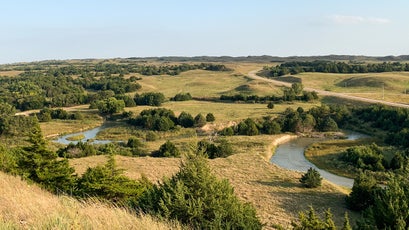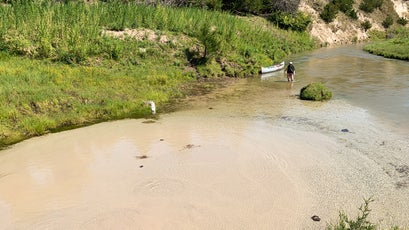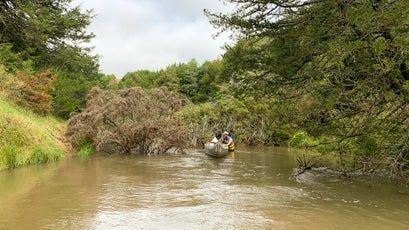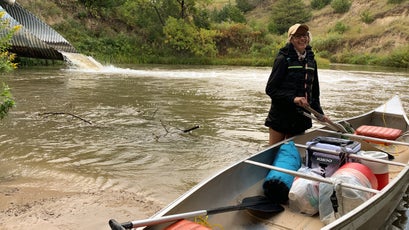An Anniversary Canoe Trip Down “Divorce River”
The author, a proud son of Nebraska, and his wife were in a funk after a move from the soothing heartland to the noisy canyons of Chicago. What better cure than a trip down a short, muddy stream that's often interrupted by dead trees and barbwire fences?
New perk: Easily find new routes and hidden gems, upcoming running events, and more near you. Your weekly Local Running Newsletter has everything you need to lace up! .
It’s the night of our second anniversary, and I’m clearing sun-bleached cow pies from our tent site. My wife, Mel, sits in the canoe 30 feet away, arms crossed, wearing sunglasses in the shade. She could be watching anything: the sinking sherbet sun, the serpentine current, the cow-calf pair mulling the water’s edge—but I know she’s watching me, silently, in solidarity with the cackling magpies and looming canyon walls. And in truth, I’m failing even this: the crusty upper halves of the pies land with a pathetic whisper on the riverbank, the rest at my feet, now bruised and blood-smeared after a grueling day on the Dismal River.
I had overshot the campground. Now we’re boondocking in a cattle pasture on private property in the heart of the Nebraska Sandhills, at least 15 lonely miles from the nearest lonely town of Seneca, population 33. We’re tired. Sunburned. Hungry. Cell service is a cute hypothetical, and despite our utter remoteness, I feel exposed, as if someone or something is stalking us from the hills above: a mountain lion reclaiming its ancient territory, or worse, the landowner.
A silver moon bobs on the water as we finally crawl into the tent. We split a can of baked beans, cooked on a fire of cow chips and cedar bark, washing it down with a box of cabernet as the crickets begin their serenade. Mel curls up next to me, cocooned in her sleeping bag. Slowly, we begin to unwind. Hardly the fresh start we were looking for, but getting closer by the minute. Before we drift off to sleep, she reveals the silver lining, as if she’d been stowing it away all along, saving it for just the right moment.
“It’ll be great for the story,” she says.
It had been a long year. We’d left a comfortable existence in Omaha for the prospect of another one in Chicago. Mel had taken a shiny new PR job in a skyscraper near the Loop. The money was great unless you factored in the time, the night sweats, the slow death by open-office plan. I had sold my first book, , just before the move, and, not yet privy to the arbitrary nature of my publisher’s timeline, was now sprinting marathons to hit one deadline after another, as if the contract would burst into flames a minute past midnight. Our dog, hypersensitive to the train growling beneath the streets, spent most of his days hiding under our bed, yearning for the grassy backyards he knew in Nebraska. He would have loved everything about this stretch of the Dismal, not least the bouquet of manure and prairie decay.
My deadlines kept coming. First the rough draft. Then the final. Then the copy edits and the fact check and the legal review. Once the text was done, a different anxiety crept in: Would anyone read a nonfiction book about a roadside zoo in rural Nebraska? Did I want them to? What if Kirkus pans it? What if Publishers Weekly calls it “a desperate first attempt by a wannabe Krakauer?” Mel admonished me to relax, to celebrate the win, to recognize that after ten years of reporting, I finally had a book. Her advice was sound, and I knew it, but none of the milestones felt the way I had always imagined they would. I didn’t feel like an author. I felt like I was playing the role of one.
In other words, we needed to reset.
Canoeing the Dismal wasn’t a new idea. I grew up on the edge of the Sandhills—nearly 20,000 square miles of grass-covered sand dunes in north-central Nebraska—and still cherished arcadian memories of the river: the springs gurgling from the banks, the lush green valleys, the white cliffs above, the tiny falls swamping our portly Boy Scout leader’s canoe, the whole troop howling with laughter.��
I hadn’t run it since I was a kid, but every few years the itch would return, and when the daily ho-hum threatened to drown us, I’d suggest to Mel that we undertake a Dismal adventure. Just me and her. An empty horizon. The sky.
But every time we discussed the trip, it would untether itself from reality. We would go to work instead. Recycle excuses. This time was different. Our lives were busier than ever, but the move to Chicago—despite our love for the city—seemed to trigger something in us both. If the stars wouldn’t align for a retreat on the Dismal, we would align them instead.
And so we found ourselves on the eve of our second anniversary in my parents’ tiny rental house in Broken Bow, Nebraska, two hours east of the put-in, stuffing our gear into drybags and debating how much alcohol was necessary for a two-day canoe trip. I recited a checklist out loud. “Water shoes?” Check. “Life jackets?” Check. “Tent?” Check. “Swimsuits?” Swimsuits? On that one, Mel raised both arms in protest.
“Our entire trip is predicated on water!” I said.
“You told me the water was cold! You said we wouldn’t be swimming!”
Fifteen minutes later, after everyone (especially my mother) agreed that I had failed to properly communicate the realities of the trip to my indubitably perfect wife, Mel and I found ourselves shuffling through the clearance rack outside Dollar General, the only store in town that maybe sold a swimsuit. Good news: it did. They were all the same style, a hot pink tankini with the phrase “Summer Vibes” splashed across the chest, the font so bold it offended us both. They were all too big. She bought one anyway.
By five the next morning, we were cruising west down Highway 2, our dented and decades-old aluminum canoe, a 16-foot , strapped to my father’s Suburban. Eager to help, my parents had agreed to drive us to our put-in. A steady rain peppered the headlights like television static, a reality each of us chose, independently, to ignore. Before cutting south for the last 12 miles, we stopped in Mullen, population 463, where the owners of the only campground on our planned route run a small motel. We rang the office doorbell three times before an older woman, torn from slumber, trudged to the door. She took our check. She trudged away.
The clouds parted as we continued south, the sun licking pools from the asphalt. A meadowlark resting on a mile marker recited a Ted Kooser poem from memory—Scout’s honor. The Sandhills beg for poetry. “It is without a doubt the most mysterious landscape in the United States,” the late Jim Harrison once wrote in The New York Times. “… The vastness and waving of the hilly grasslands in the wind make you smell salt.” More cows than people. A loneliness endemic to this terrain, one of the largest grassland ecosystems in North America. Staring out the back window, I could feel the adventure creeping in, my chest tightening as the hills slalomed toward infinity. I hoped Mel, still groggy, could feel it, too.
Cresting a minor summit, we finally spotted the river, cedar trees crowding the valley, a latchkey willow tagging along. Long known to the Lakota and other tribes who utilized the Sandhills, the Dismal wasn’t truly explored by Euro-Americans until 1870, when Yale’s O.C. Marsh, the first paleontology professor in the country, led his students up the river on a fossil-hunting expedition. Before all that, poet Ron Block claims in Dismal River, his book-length narrative poem, there “came a frontier giant who / despaired at the sight and let his stick drag / got drunk on the distance and pissed himself a river.”
In reality, the Dismal—just 80 miles long—rises from the Ogallala Aquifer and flows east toward the village of Dunning, where it merges first with the Middle Loup, then the Loup, then into the Platte, and finally flushes into the Missouri. The entire stretch slithers through private ranchland, except for a short drag flanking the Nebraska National Forest, near Halsey. So while the water belongs to the people, the riverbed does not, and ranchers can, and frequently do, run barbwire across the water. Combined with a surfeit of natural strainers, mostly dead cedar trees, the Dismal has earned itself a nickname: Divorce River.
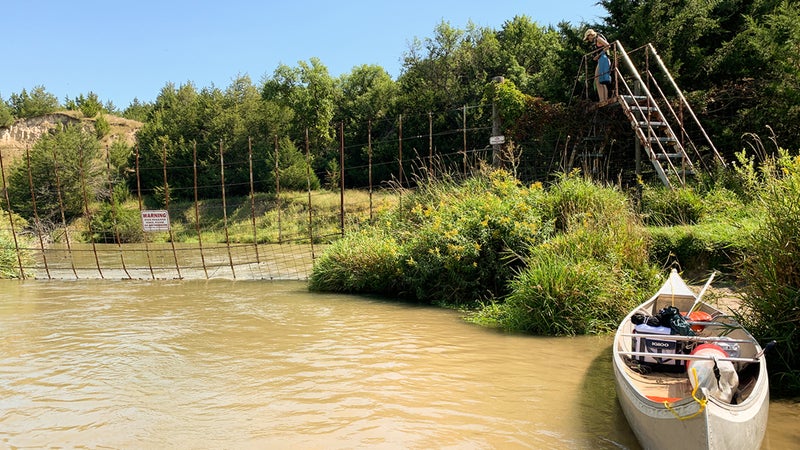
In the days leading up to our trip, I’d joined a Facebook group called , inquiring about the current state of the Dismal. I’d been warned that it was getting harder to navigate, that fallen trees were far more numerous, that landowners were less accommodating, that the river ran high this year. A local EMT wrote: “Believe me when I say we can’t easily get ourselves anywhere near you, even if you CAN notify us of an injury. It could be a long hike in and a long hike out to reach you.” Doing the river in full takes three days; most paddlers bow out after just one. The Facebook crew said day two was especially challenging, that few had tried it this year. One user called it a “flat out rodeo.” And yet enthusiasm for the experience ran high. All the good-natured exclamation points put me at ease.
“The Dismal will beat you up a little,” one user said, “but it’s a great adventure!”
We soon pulled off into a muddy cul-de-sac, unstrapped the canoe, and dragged it through the trees until the trail disappeared. Twenty feet below, a dead garter snake lie bloated in a mud bath, attracting flies in a macabre welcome.
Using a knotted rope that some Good Samaritan left behind, I rappelled down the cliff and sank knee-deep in mud. My dad lowered the canoe, and Mel joined me in the muck, arms loaded with gear. We waved goodbye, thrust ourselves into the current, and with the sun still ahead of us, got underway.
Not 30 yards from the start, we hit our first barbwire challenge. Some fences—like the one before us—hang so low that you can simply glide over the top, while others are so high that you can limbo beneath or so slack that you can raise them with a paddle. But many others force you out of the canoe entirely, one person parting the wires, the other guiding the boat between them.
Within an hour, we’d found our rhythm: Mel as bowman up front, scouting obstacles, barking commands (“Stay left,” she would shout. “Other left!”). Me as grunt man in the back, steering the canoe, playing tour guide on a river I barely remembered. We maneuvered our aluminum tank with aplomb, anticipating the oxbows, how the current seemed to rush and fold around every bend, where to expect strainers or sandbars. Confidence blooming, we began to appreciate our surroundings: sunflowers dappling the shore, secret brooks resounding across the water, cliffs sheared away like a museum exhibit, a perfect cross section, every sandy layer on display. Ducks and doves and red-tailed hawks. Blue jays and bitterns and black-billed magpies.
The campground at the Seneca Bridge was around 12 miles downstream from the put-in, a roughly six-hour float. Halfway there, we hit our first landmark: the boiling sand spring. Thanks to the small herd of black cattle we flushed from the banks, their awkward frenzy wafting a cloud of dust across the water, we nearly missed it. There are no markers. No informational placards. Just a paw-shaped hole eroded from the bank, maybe 20 feet wide, filled with a pool of shifting sand. We tied the canoe to a shock of bunchgrass and hopped out. A film of gin-clear water rides atop the sand, large bubbles burping to the top—a true Sandhills fountain. I tested the spring’s depth with my paddle, couldn’t hit bottom, let go, and watched it spring back into my arms.
How often does one experience a natural phenomenon like this? No rules for observation. No walkways or ropes. No crowds or selfie sticks or admission fees. It was a common refrain for us throughout the trip: How truly wild the Dismal still is. How rare the experience. Back in Chicago, our river literally runs backward, the whole thing reengineered to flush sewage away from the lake. But the Dismal is virtually untouched: no levees, no dams, no electric skyline, no million-dollar condos peering down from above. How petty it seemed to protest a little barbwire, when you get all this in return.
Twenty minutes past the spring, we pulled the canoe up to a grassy island. We reclined on our life jackets, split a Shiner, popped some blueberries, forgot about the book, the job, the city, our stupid millennial expectations. I turned to Mel, her arms spread wide to catch the sun. She was smiling.
“Summer vibes,” I said.
“Summer vibes,” she agreed.
Less than an hour later, we spotted a weathered stop sign littered with buckshot and nailed to a tree on the bank. This meant little to us until we hit some mild rapids and noticed the falls up ahead. To call them “falls” is perhaps a stretch, though everyone out here does: the river narrows, churns into a frenzy, drops several feet from a sandstone ledge, and rushes forth through a long chute. But if you don’t hit it right, if you approach it crooked or careless or blind, it can easily flip a canoe. Many simply portage around it.
We forged ahead. Adrenaline pumping now, we hit the falls perfectly, barely dropping in the canoe, then quickly lost the streamline and lodged ourselves in the chute. A minor hiccup, all things considered. We were still upright. Our gear was dry.
I swung my legs from the canoe, ready to stand on the bottom and push us free, but my feet never landed. I sank like a brick, all the way under, then burst to the surface, coughing and gasping for air. The cold shocked me, a spring-fed 68 degrees at the tail end of summer. My glasses bobbed in the water. I put them back on, aligned us parallel to the chute, and hopped in. I acted casual about the misstep, laughed it away, but for a minute my heart raced, my jaw locked. It was my first reminder of the Dismal’s trickster ways.
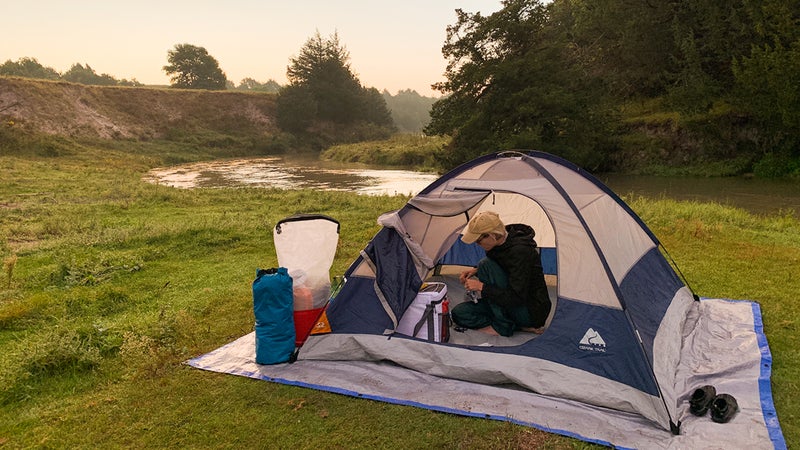
Nebraska boasts nearly 80,000 river miles, and the majority are shallow and sandy and fit for the laziest among us. I don’t condone getting drunk on a river, but if it happens, Nebraska is an ideal place to be. The Elkhorn, the Platte, the Republican, the Loup, the Calamus, most of the Niobrara—they’re all considered easy on the , Class I, lethargic as a retired cow dog. It’s why you’re more likely to find a Nebraskan riding an inner tube or—God save us—a cattle tank: for the most part, paddles are more accessory than necessity here.
But the Dismal is something else. Wide and slow one minute, narrow and perilously swift the next. It cuts left when you’re veering right, pivots instantly from sand to stone. The bed plummets when you need the footing. It pulls the rug out beneath you. Block’s poem reinforces the river’s menace at every turn, couched deceptively in the Sandhills’ mellow curves:
For one hundred years, the Dismal clawed
at the cedar-bluffs like a man half-buried,
his heart quick with panic, digging with
the dull knife lightning lost in the water.The valley deepened like an open grave,
and now the river searches back and forth
like a blood dog with its nose to the ground,
the moon pumping up, swollen, panting in the heat.
The water relaxed again after the falls, but soon we hit another fence, not barbwire this time but a wall of steel mesh ten feet high. A sign said: “WARNING. State regulated fence. Please do not vandalize. Violators will be prosecuted.” Somewhere out here, I’d been told, a former NFL player had established a big-game ranch: bison, elk, deer. Surely this was it. A single rusty staircase rose up and over the barrier. Below it, a warped wooden box and another sign that read: “For Portage.” We climbed the stairs, shoved the canoe through the box and continued on our way. No problem.
Two miles later, we hit another fence. Same style. Same ladder. But the portage flap wouldn’t budge, and even if it had, the box was too narrow. We finally succeeded in lifting the canoe up and over the staircase, but not before two failed attempts that left us panting in the grass—two jaded Sisyphuses and our boulder of a canoe. Had either of us been alone, we’d have spent the rest of the trip backpacking to the nearest ranch house, our canoe marooned on the banks.
When we finally passed beneath the Seneca Bridge a few hours later, we scanned the banks for a pullout, a sign, something to indicate we’d hit the campground. “It must be around the bend,” I told Mel. Then, ten minutes later: “It must be around the bend.” And before we knew it, we had floated another two miles downstream.
“You said there’d be signs,” she said.
“I thought there’d be signs.”
Now I lie awake beside her, the walls of our nylon tent aglow with moonlight. I feel guilty, will for days, though I know she’s quick to forgive. A lone coyote yips in the distance. Now another, and another, and soon the whole valley is a primal symphony. Mel sleeps right through it, her breathing deep and slow. Tomorrow she’ll tell me it was the best sleep she’s had in months.
The next morning we’re on the water by 7:45, the grass still heavy with dew. Our first day had been challenging, but aside from the fencing, the lost campground, and the trespassing, it mostly aligned with my expectations. Abundant wildlife. A quick thrill at the falls. Plenty of sun and sand.
Day two feels different already. Dangerous somehow.
Rounding the first bend, the hills shoot up around us, dark and densely forested, casting a shadow across the water, more Black Hills than Sandhills. We put on our rainjackets for the warmth; we keep them on for the protection, the obstacles multiplying with every turn, the room to maneuver quickly disappearing, the canoe plowing through fallen cedars, sticks and spiders raining down from above, orb weavers and daddy longlegs scurrying around in the canoe, beneath our collars, our hats, our shoes.
The next three hours grow worse with every stroke. We can’t outwit the current. Our communication fails. The flow quickens as the banks squeeze in. Soon we’re pinballing back and forth, ramming through one skeleton cedar after another. Mel tries to hold the branches for me as we pass, but they rifle back twice as hard, pummeling me over and over again.
Unbeknownst to us, we’ve entered a section that regulars call the chutes.��Trees stitch out the sky. The shore disappears. The riverbed sinks and turns to stone, and a motley beard of roots shrouds the banks. Suddenly, we’re yelling over the current, so strong now it’s drowning heavy logs, trees bobbing and struggling for breath.
“From now on,” I shout, “the question isn’t, can we make it, but should we even try? I’d rather jump out and guide us than swamp the canoe.”
Over the next two hours, I jump from the canoe at least a dozen times, slamming my legs and feet against invisible sandstone, trying my best not to wince. I’m soaked and freezing, which helps numb my swollen knees but does little to calm our nerves. We keep pushing forward, but slower now, cautiously, zigzagging through the labyrinth, using our paddles to shield the blows. The chute grows darker; up ahead, a quick succession of downed trees hang over the water, first to the right, then the left. “We can’t make it!” Mel shouts, and even from the stern, I can tell she’s right. The physics don’t play. The river’s too narrow, our canoe too long, the current too swift.
I roll out, slam my knee on the rocks. I can’t find bottom but somehow manage to wrestle us around the first tree. Mel shoots forward, grabs a mess of roots, and pulls the canoe tight against the left bank. I float past, still unmoored, but catch an overhanging branch and reel myself in. A narrow sandstone shelf lies at the foot of the bank, just below water. I climb on top, my left knee throbbing. I pivot toward Mel, still in the canoe ten yards upstream. She steps out, shivering, and at my command sends the canoe my way. I tie it to a branch overhead and shuffle back to join her.
There’s another wall of trees ahead, a tight window on the far side, beyond which everything is obscured, a rat’s nest of clacking timber. If I can make it to the other side, I think, testing the current. It kicks my legs out, sweeping me downstream and pinning me against the canoe, my chin locked on the gunwale, my feet bouncing like a rag doll beneath the hull. It takes all my strength to scale back to solid ground. Shadows flitter across the water. For the first time in a long while, I’m genuinely scared. This isn’t the Dismal I remember. I have no fucking clue what’s ahead, and the EMT’s warning comes rushing back: “We can’t easily get ourselves anywhere near you.” We’re utterly alone.
I boost Mel up into the trees to get a better look. I boost Mel into the woods above. She hikes downriver; I can’t hear a thing.��I can’t hear a thing. My mind races. She’s been gone only minutes, but it feels like an hour. When she finally returns, she brings good news: the river is clear ahead. If there’s any way to push through, we’ll have an easy run. I ask her to wait for me downstream, to call my name every 30 seconds. I tell her I have a plan. I don’t have a plan.
She trudges off, then returns seconds later.
“I love you,” she says. She’s crying.
When she disappears again, I plant my feet, aim for the window, and send the canoe ahead, holding tight to the rope. The keel lodges in the crook of a gnarled cedar trunk. Mel shouts: “Carson!” I reel it back, try it again, but I can’t find the strength, or the angle, or the leverage. “Carson!” Finally, I test the trunk itself. From a distance, it looked like it was floating, but it hardly moves when I step on top. I inch my way out across the river, ass in the air, feeling the water rush beneath me. “Carson!” I crouch down, kick the boat loose, and slowly redirect it through the window. I jump back in to ride the rest of the way out, my body locked, as if I’ve been flinching for hours.
When I hit the clearing, I return the call. “Mel!” She’s standing in the sun, high atop the hill, her legs feathered in bluestem. She waves and yells my name, and though we’ve only been separated a few minutes, I’ve never been so glad to see her.
We still have hours to go before the end of our journey, but we’ve cleared the chutes at last. The river widens and the trees thin and the hills return to the soft, hogback moguls I’ve always known. We stop in a lush, green inlet a few miles downstream, split another beer, spread our gear out to dry. A blue heron lifts from the water’s edge, its pale belly gliding overhead, wings outstretched. Soon enough we’ll be complaining about the heat and the wind—now we’re too exposed—the shallow water, the sandbars, the telephone poles and county roads teasing us with civilization long before we’ve made it. But for the moment, we’re content to sit here in the sun, our bodies slowly unwinding from a flat-out rodeo.
“Summer vibes?” I try again.
She’s trying not to smile.
“Let’s finish this,” I say.
We follow the heron.



